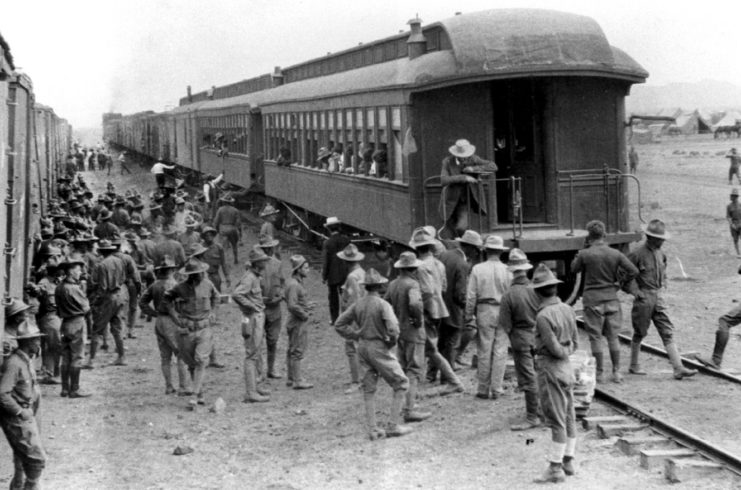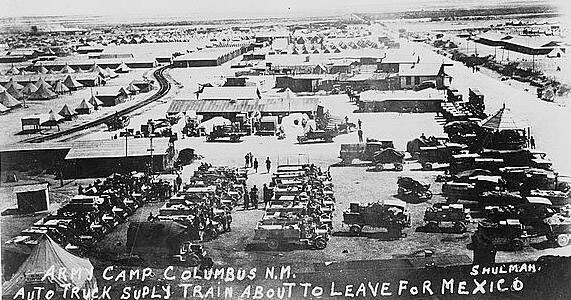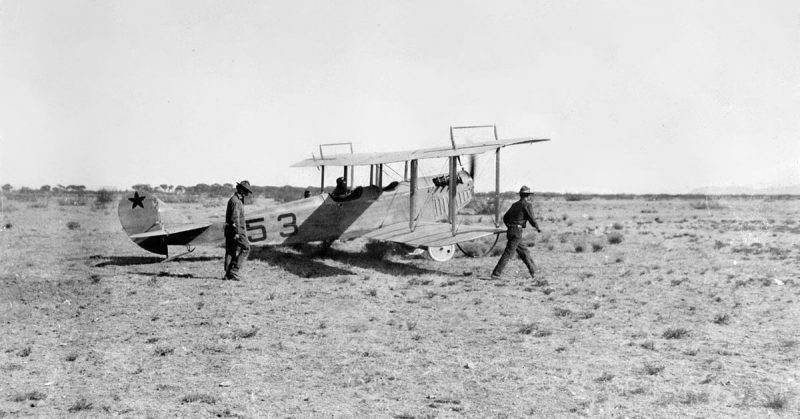At the request and encouragement of some military historians, Western historians and other interested parties, author John L. Deuble, Jr., has turned an apparent labor of love, along with his related previous articles and presentations, into a publication. It photographically details, with some accompanying explanatory text, captions and lists, the history of the Army’s 1st Aero Squadron and its support of the United States’ punitive expedition into Mexico, following Pancho Villas’ raid, from its base at Camp Furlong in Columbus, New Mexico, where the raid occurred in March, 1916.
For over a year, the squadron provided reconnaissance, scouting, intelligence and logistical support with its aircraft, mostly of different models of the early “Jenny” type biplane. Its pilots included some of the early, and even later (as in World War II), who’s who of the pioneering class of American aviation, including Benjamin D. Foulois (America’s first military aviation prisoner of war, fortunately only briefly), Carl Spaatz and Millard Harmon. Interestingly, information is also provided on the first American military motorized, as in vehicular, component employed to render additional logistical and maintenance support to an aviation mission.
As an illustrated history, there is relatively little straight-out text and more emphasis on statistics, accomplishments and, of course, photographs. What might actually be considered the text is the prologue and first chapter which relate the actions of the punitive, yet unsuccessful, expedition and the air support it received during its “sojourn” in Mexico. Any additional text would be the lists of statistics, descriptive information of equipment and biographical data of personnel.
Although the basis of the book revolves around the squadron’s actions during this military campaign into Mexico, its format is composed of eight chapters which cover a multitude of topics: Pilots and other personnel, quarters, aircraft flown and their equipment (in particular, the aerial camera used for purposes of reconnaissance, scouting and intelligence), the creation and employment of the Motor Transport Division referenced above, machine shops and other support facilities, a description of the aerodrome itself and, lastly, a chapter on “special squadron topics” which is largely a series of lists of the squadron’s aviation accomplishments and other vital statistics such as those killed in the line of duty, decorations and honors received, etc.

Not surprisingly, the many photographs included provide an up close look at the pilots, their aircraft, the climatic and topographic conditions under which they operated, the aerodrome from which they flew, aviation badges awarded upon completion of training, campaign medals and other ephemera. Each is given a caption, usually in paragraph length, specifying the subject shown and other pertinent information such as individual’s name, date, location, etc. Although many might not be interested in such things as photographs of machine shops or hangars, there is much to glean in these to show the types of available equipment and facilities of the early days of American aviation.
What should be of interest are the photographs taken in Mexico as the campaign progressed, much to the apparent displeasure of the local inhabitants. The involved formations created bases along the way to support their advance, using the motor transport division for provision of parts, materials, supplies, food and ammunition. The aircraft were occasionally used to ferry mail besides their other duties.
Creditably, there are two maps. One shows the area of northern Mexico in which the expedition operated in its bid to punish Pancho Villa for his border transgression. The other depicts Columbus, New Mexico, and the airfield’s proximity to the town and, ironically, Pancho Villa State Park. Currently, the airfield has been incorporated into the local airport although, certainly, the facilities have since been updated and modernized, the runway paved and so on.

Although there is no index, the bibliography does show extensive research in archival materials, books, articles and newspapers. These sources provided much of the biographical, technical and statistical information listed. Also, a glossary defines many acronyms of which the military is so fond, including REO (for Ransom Eli Olds Motor Car Company) which sold the Army at least one of the truck models, nicknamed the Speedwagon, used in transport and apparently is the arcane source of the name of the ‘70s-‘80s rock band of the same appellation.
Despite the very specialized, if not relatively obscure, nature of the topic of this book, there is something here for those with a bent toward early 20th Century aviation, interest in the 1st Aero Squadron, one hundred year old photography or just the border “war” fought with Mexico, thanks to Pancho Villa. To that extent, it can be recommended.
An Illustrated History of the 1st Aero Squadron at Camp Furlong: Columbus, New Mexico 1916-1917 by John L. Deuble, Jr. Albuquerque, N.M.: n.p., 2016. 182pp. $25.00. Softcover.
Stuart McClung
